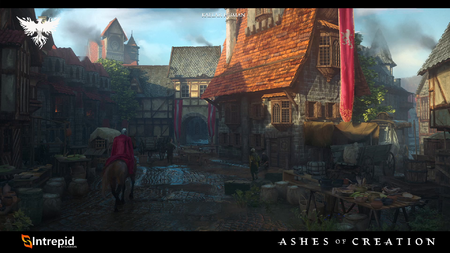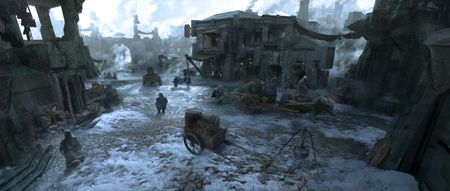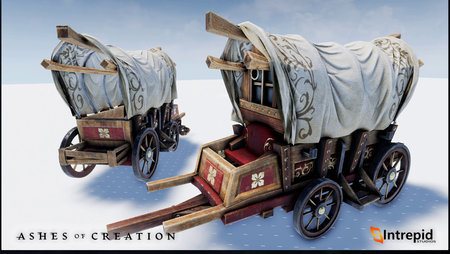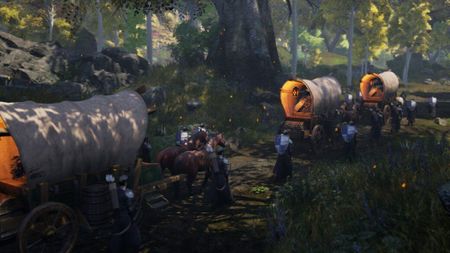Städte
A town is the fourth stage of node advancement.[3]
When a Village becomes a Town, there are even more permanent structures, and a continued established local government. The development area feels well lived-in and developed at this point. Societies and Organizations begin to patronize the Town with ranking structures for players to participate in.[4] – Margaret Krohn
Entwicklung der Node
Alle Aktivitäten (Aufträge, Sammeln, Schlachtzüge, etc.) welche von Bürgern sowie allen anderen Spielern innerhalb des Einflussbereichs einer Node ausgeführt werden, tragen zum Wachstum (Fortschritt) dieser speziellen Node bei.[4][5]
Durch das Wachstum einer Node werden einerseits deren einzigartigen Inhalte freigeschaltet, andererseits wird der Fortschritt der umliegenden Nodes auf die nächste Stufe blockiert.[6]
- Nodes steigen schnell auf die erste Stufe auf. Dadurch entstehen die ersten NPC-Dienstleistungen, beispielsweise der Verkauf oder die Aufbewahrung von items.[7]
- Je fortgeschritttener die Node ist, desto größer ist ihr ZOI.[3]
- Weniger weit fortgeschrittene Nodes (auch Vasallen-Nodes genannt), welche im Einflussbereich einer höherstufigen Node liegen, können weiterhin Erfahrung sammeln, jedoch müssen sie stets mindestens eine Stufe unter der ihrer übergeordneten Node bleiben.[8]
- Das Vasallen-System tritt erst ab Node-Stufe 3 (Dorf) in Effekt, jedoch blockieren Nodes bereits ab Node-Stufe 1 (Expedition) das Wachstum ihrer direkten Nachbarn.[9][10]
- Der Algorithmus zur Gebietserweiterung berücksichtigt nahegelegene Küsten, benachbarte Nodes, und die am häufigsten Besuchten Orte von Spielern innerhalb der letzten Woche, bzw. des letzten Monats.[11]
- Aufgrund der Art und Weise, wie dieser Algorithmus den neuen Einflussbereich während des Aufstiegs berechnet, kann es vorkommen, dass zwei Nodes mit der gleichen Node-Stufe nah beieinander liegen.[12]
Die Art und Weise, wie der Algorithmus die Gebiete erweitert, berücksichtigt einige Dinge: Erstens berücksichtigt er die Küste, beispielsweise wo die nächstgelegene Küste ist. Zweitens berücksichtigt es die benachbarten Modepunkte, sodass es diese Nodepunkte übernehmen und im Wesentlichen zu Vasallen machen kann. Wichtiger ist jedoch im Wesentlichen die anfängliche Bevölkerung, die darauf basiert, wie die Spieler ihre Rassen auswählen. Da wir neun verschiedene Rassen und vier verschiedene Startpunkte haben, die sich verzweigen, bestimmt die Bevölkerungsdichte jedes Servers im Wesentlichen die ersten paar Knoten, die stark bevölkert sind, und dieser anfängliche Samen bestimmt dann die Knotenstruktur, wenn er landeinwärts wandert das in die Welt im Wesentlichen; und basierend auf der Leistung und den Erfolgen verschiedener Belagerungen wird bestimmt, welche Node, die von den vorherigen anfänglichen Weiterentwicklungen ausgeschlossen wurden, welche Node jetzt für weitere Fortschritte verfügbar sind. Ich glaube also wirklich, dass bei so vielen Variablen, die in der Gleichung dafür vorhanden sind, wie Nodes voranschreiten und bestehen bleiben, die Wahrscheinlichkeit umso höher ist, dass es zu einer erheblichen Abweichung im Weltfortschritt kommt, je mehr Variablen man hat.[11] – Steven Sharif
Normalerweise verhindert der Algorithmus, der auf die territoriale Erweiterung der Node angewendet wird, dass wichtige Knoten nahe beieinander liegen Es gibt bestimmte Anforderungen, die verfügbar sein müssen, um Nodevasallenübernahmen zu erfüllen. Und es ist möglich, dass zwei Nodes sich niemals gegenseitig als Vasallen übernehmen und am Ende nahe beieinander liegen und ihre Territorien in entgegengesetzte Richtungen umspannen: Die Sache mit der Geschichte zweier Städte.[12] – Steven Sharif
- Vasallen-Nodes geben überschüssige Erfahrungspunkte erst dann an ihre übergeordnete Node weiter, wenn sie ihre Level-Grenze erreicht haben..[8]
- Die Möglichkeiten, für eine Node Erfahrungspunkte zu sammeln, sind für alle Arten von Nodes gleich.[14]
- Um Manipulation zu vermeiden, ist die exakte Anzahl an hinzugefügten Erfahrungspunkten für die Node durch das Erhalten von Gegenstände oder dem Töten von Gegnern nicht bekannt.[15]
Verschiedene Leute investieren unterschiedliche Ressourcen in die Weiterentwicklung von Nodes, und es wäre ein wenig „spielerisch“, wenn man genau wissen könnte, was zu diesem Zeitpunkt notwendig ist, denn das würde die Leute von der Teilnahme abhalten.[15] – Steven Sharif
Verschiedene Animationen und visuelle Effekte innerhalb der Grundfläche einer Node leiten den Beginn des ihres Aufstiegs ein.[16][4]
- Spieler, die sich zu diesem Zeitpunkt innerhalb der Node befinden, werden zu einem sicheren Ort teleportiert (beispielsweise einem Spawn-Punkt).[16][17]
- Um die Node herum spawnen Materialien, welche von systemgesteuerten Karawanen in die Node transportiert werden. Diese Karawanen können nicht angegriffen werden.[16]
- NPCs beginnen mit den Bauarbeiten.[16]
- Spieler, welche sich außerhalb der Node befinden, können die stufenweise visuelle Transformation der Node beobachten.[16]
Das Entwicklungsgebiet eines Nodepunktes ist der Ort, an dem die Zivilisation erscheint, wenn der Knotenpunkt voranschreitet. Mit zunehmender Nodestufe werden im Entwicklungsbereich verschiedene Gebäude, NPCs und Dienste verfügbar. Je höher die Nodestufe, desto komplexer und bevölkerter wird das Entwicklungsgebiet. Entwicklungsgebiete variieren auch je nach Knotentyp – wirtschaftlich, militärisch, wissenschaftlich oder göttlich.[4] – Margaret Krohn
Vasallen-Nodes

This vassal mode structure tells you what it looks like for a sovereign at a level six metropolis stage; and what it can control at a maximum vassal network is two level five nodes, of which a level five node can control one level four and one level three as direct vassals; and then the four can control a three; and every three can control a one or a two. Now if the three gets removed through siege, the one or the two is removed as well. So that's an important distinction between the three's vassals, which technically isn't really a vassal relationship because there's no citizenships possible. Those vassals don't exist between three and X, but they do exist between four and three, five and four, and six and five. And what this also allows is that because there are 85 nodes that are within the world, we have a buffer zone of about 20 nodes that lives in a max server state. So if you had maximum five metropolises form in a world, you will have a number about 20 nodes that can live alongside those metropolis networks; and when or if a metropolis falls, that extra cushion of nodes around the five metropolis structures allows for the map to be redistricted in a way that is unique. It doesn't mean that one of the fives is just going to pick up where the last six left off and form the same exact metropolis structure. From a territory perspective it has ancillary nodes to play with and expand towards that redistricts the map, so that if a metropolis falls there's a significant difference in the layout of the world and the layout of these almost nation-like territories.[18] – Steven Sharif
Village (stage 3) or higher nodes enslave nearby nodes, converting them into vassal nodes.[19][10]
- A Metropole (Stufe 6) can control up to two Großstadt (Stufe 5) nodes. A Großstadt (Stufe 5) can control one Stadt (Stufe 4) and one Dorf (Stufe 3) node. A Dorf (Stufe 3) can control an Feldlager (Stufe 2) or an Expedition (Stufe 1). If the Dorf (Stufe 3) gets destroyed through a siege, its dependant Feldlager (Stufe 2) and Expedition (Stufe 1) nodes are also destroyed.[18]
- There is a layer of intricacy between how the neighboring nodes advance and what potential parent structure they have in the vassalship tree.[20] – Steven Sharif
- Vassal nodes gain benefits from their regent node (also referred to as sovereign node or parent node) even if the node type of the parent is different to the vassal.[21][22]
- It is not a bad thing to be vasseled, it is a good thing to be vasseled. It brings many benefits from the Sovereign, which is the ultimate parent of that vassal network down to the vassal node itself; and it allows that vassal node to even live outside of its normal mechanics. You get to adopt some of the benefits that the node type of your sovereign is, even if your node type as a vassal node isn't the same.[22] – Steven Sharif
- Regent nodes collect taxes from their vassal nodes. These taxes cannot be taken by the mayor or other players.[24]
- Vassal nodes must remain at least one node stage below their parent node.[19]
- Neighboring/Adjacent nodes from Expedition (Stufe 1) upward block the growth of their immediate neighbors. This was intended to be tested in Alpha-1.[9][10]
- Vassal nodes first apply any experience earned to their own deficit (see Atrophie des Knotenpunkts). It then applies excess experience earned to its parent node.[4]
- If the parent node advances, the vassal is once again able to advance.[19]
- Vassal nodes give excess experience to their parent node and may have their own vassals; so long as they fall within the parent node’s zone of influence.[24][19]
- If a node is capped and is both a vassal and has its own vassals, any experience earned from itself or its Vassals is first applied to its own deficit. Experience beyond that is then sent to its parent node.[4]
- When the vassal reaches its cap it overflows experience up to the parent; and so it can be very good early on for parents to get vassal nodes that are very productive- that have a lot of traffic.[24] – Steven Sharif
- Vassals are subject to the government, alliances, wars, taxes, and trade of their parent node, and are able to receive federal aid from them.[19]
- Vassal nodes cannot declare war on their parent node or any of their vassals.[19]
- Citizens of vassals are bound by the diplomatic states of the parent node.[19]
- If a Node is a Vassal Node and is capped from advancing further, it first applies any experience earned to its own deficit (see Node Atrophy section), and then applies excess experience earned to its Parent Node. If the Parent Node advances and the Vassal is able to grow, it becomes uncapped. If a Node is capped and is both a Vassal and has its own Vassals, any experience earned from itself or its Vassals is first applied to their own deficit. Any experience beyond that is then sent to its Parent Node.[4] – Margaret Krohn
Node layout and style

Das Layout und die Architektur innerhalb des Siedlungsgebiets einer Node werden durch die einflussreichste Volk bestimmt. Eine Node der Stufe 3, bei dem die Mehrheit der Spieler Py'rai sind, wäre zum Beispiel ein Py'rai-Dorf mit Py'rai-Architektur. Die meisten NSCs wären Py'rai-Elfen und würden Questlinien innerhalb der Py'rai-Erzählung anbieten.[19] – Margaret Krohn
Der Beitrag eines jeden Spieler wird mit dem entsprechenden Volk und anderen Faktoren makiert. Wenn eine Node aufsteigt, bestimmt das Volk dass am meisten beigetragen hat, den Stil und die Kultur der Node. Dieser Stil und Kulturwechsel kann bei jedem Stufenaufstieg statt finden. Wenn zum Beispiel eine Node auf Stufe 2 – Lager – aufsteigt und 51% der Beiträge von Ren’Kai kamen, wird die Node im Stil der Ren’Kai sein. Wenn die selbe Node zur Stufe 3 - Dorf – aufsteigt und Py’Rai 62% der gesammten Leistung beigetragen haben, dann ist die Node ein Py’Rai Dorf.[4] – Margaret Krohn
Das Layout und der Stil einer Node wird durch viele Faktoren bestimmt:[25][26]
- Das Node-System ist so konzipiert, dass diese in 18 verschiedenen Biomen existieren können, aber gleichzeitig die kulturellen Merkmale eines Volkes repräsentieren werden, die fester Bestandteil eines spezifischen Bioms sind.[27] – Steven Sharif
- Umgebung (Biome) und Standort der Node.[27][25][26]
- Die Node passt die lokale Topographie an die ästhetischen und strategischen Anforderung der Node an.[28]
- Derzeit ist das Plattformsystem so konzipiert, dass es die Topografie der Stellfläche der Node unabhängig vom umgebenden Terrain anpassen kann. Der Grund dafür ist, dass wir bei der Gestaltung des Node-Layouts flexibel sein wollen, und zwar sowohl aus ästhetischer Sicht als auch aus mechanischer Sicht mit den Node-Belagerungen - wie sie aufgebaut sind, und diese Bauweise sollte in der Lage sein, eine Vielzahl verschiedener Arten von Topografien zu berücksichtigen. Das heißt, es sollte nicht von der Umgebung abhängig sein. Das heißt aber nicht, dass die Umgebung nicht einen gewissen Einfluss haben wird. Wir experimentieren zum Beispiel ein wenig mit der Plattformtechnologie und stellen eine Node an die Seite eines Berges, am Rande einer Klippe oder an einem Standort, der eine schöne Aussicht bietet. Das sind natürlich Dinge, die wir ausprobieren werden, während wir weiter am Node-Tool arbeiten und daran, wie das Plattformsystem funktioniert, aber die Idee ist, dass die Nodes unabhängig vom umgebenden Terrain sind.[28] – Steven Sharif
- Einige Teile werden durch das Gebiet bestimmt, in dem sie sich befinden. Einige Teile werden durch den Typ bestimmt, der sie ist. Einige Teile werden durch die Völker bestimmt, und der Rest wird vom Bürgermeister bestimmt.[26] – Jeffrey Bard
- Das Volk, dass am meisten zum Fortschritt einer Node beigetragen hat, wird die Ästhetik der Gebäude, NPCs und Ausstattung bestimmen.[29][30][25][4][26][31][32]
- Das übergeordnete Volk werden nicht ihre kulturellen Einflüsse kombinieren. Zum Beispiel zählen die Py'Rai und Empyrean als verschiedene Kulturen. Das übergeordnete Volk, die Pyrian, existieren nicht mehr.[33]
- Der Stil und die Kultur einer Node kann sich bei jedem Aufstieg verändern.[4]
- Das trifft auf alle Nodes zu, Burg-Nodes eingeschlossen.[34]
- Alle Nodes, unabhängig davon, ob sie mit einer Burg oder mit einer normalen Node-Struktur verbunden sind, unterliegen kulturellen Einflüssen, die sich auf die gebauten Gebäude und die vorhandenen NPCs auswirken.[34] – Steven Sharif
- Der Rest wird vom Bürgermeister bestimmt.[26]
- Es wird möglich sein, dass eine Node mehrere Bauprojekte innerhalb der einmonatigen Amtzeit eines Bürgermeisters fertig stellt.[35]
- Q: Wie lange werden die Spieler im Durchschnitt brauchen, um einen Node komplett von der Wildnis bis zur Metropole zu bewohnen/auszubauen?
- A: Es ist eine Sache, eine Node auf ein bestimmtes Niveau zu bringen: es ist eine andere Sache, diese Node weiter zu entwickeln; und ich kann dir nicht wirklich eine Durchschnittsvorhersage geben, weil eine Menge Variablen im Spiel sind. Es geht darum, wie viele Bürger die Node angezogen hat; welche Art von Verkehr die Node anzieht, basierend auf Dingen wie seinen Steuersätzen oder der Spezialisierung, die sie gewählt hat, basierend auf den Gebäudetypen, die sie gebaut hat. All diese Dinge sind Variablen, die die "durchschnittliche Ausbaudauer" einer bestimmten Node beeinflussen können. Es ist also schwierig, einen Durchschnittswert anzugeben, wenn es so viele Variablen in diesem Bereich gibt. Aber die Idee ist, dass wenn es ein bestimmtes Projekt gibt, an dessen Entwicklung die Spieler interessiert sind, basierend auf der Node-Stufe, dass sie die Möglichkeit haben, mehrere dieser Projekte innerhalb einer einzigen Amtszeit eines Bürgermeisters abzuschließen; und eine Amtszeit eines Bürgermeisters ist ein Monat.[35] – Steven Sharif
Racial influences
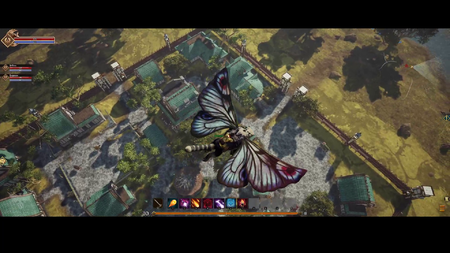
Wir haben im Wesentlichen Sets, die über alle Rassen hinweg existieren; und jede Rasse, die diese Rüstungssets trägt, wird ihren eigenen rassischen Einfluss auf die Präsentation dieser speziellen Sets haben. Das ist etwas Einzigartiges in der Art und Weise, wie jede der Rassen diversifiziert wird. Je mehr eine bestimmte Rasse zur Entwicklung einer Node beiträgt, desto mehr manifestiert sich dies in den architektonischen Einflüssen dieses bestimmten Nodes. Ihr werdet sehen, wie sich die Architekturen dieser Rassen auch innerhalb der Nodes manifestieren: Das ist eine weitere Art, wie wir jede Rasse diversifizieren und die Kultur jeder Rasse im Spiel durch diese Architekturen, durch diese existierenden Requisiten, durch die Schneiderei präsentieren der Rüstungssets, die der NPC tragen könnte, zu den verschiedenen existierenden Fraktionen. Fraktionen werden auch ihre eigene Zugehörigkeit zu verschiedenen Rassen haben. Jede Rasse wird auch eine andere Nomenklatur haben, wenn es um die Überlieferungen oder Orte in der Welt geht. Sie werden auch ihre eigenen sprachlichen Einflüsse haben: Die Art und Weise, wie sie sprechen, wird zwischen den Rassen unterschiedlich sein; wenn Sie Dialogbäume mit bestimmten NPCs haben. All diese Dinge tragen also wirklich dazu bei, eine immersive Welt zu schaffen, in der die Kulturen ihre eigene Identität haben[29] – Steven Sharif
Kulturelle Einflüsse manifestieren sich in vielerlei Hinsicht, von der Node und Ausrüstungsästhetik bis hin zu NPC languages und Überlieferungen. [29][37][4]
- Das Aussehen der Ausrüstung bestimmter Rüstungssets wird von der Rasse des Spielers beeinflusst. [29]
- Das Nodelayout und der Stil werden von der Rasse beeinflusst, die am meisten zu dieser Node beiträgt. [29]
- Vorteile können für Bürger der dominanten Kultur gelten, können aber auch für Mechaniken der Node gelten, was auch für Mitglieder andererRassen von Vorteil sein kann. [37]
- Es gibt Zermürbungsmechanismen, die Erfahrung und Einfluss beeinflussen, um eine einzelne Rasse davon abzuhalten, die ganze Welt zu dominieren. [38]
- NPCs reagieren unterschiedlich auf verschiedene Characterrassen. [39]
- Languages werden zwischen NPC Völker und in der Geschichte unterschiedlich sein. [29]
Es gibt eine Abnutzung und diese Abnutzung von Erfahrung und Einfluss wird basierend auf der Leistung des Rennens in der Welt erhöht. Wenn also all diese Nodes Ork-Nodes sind, dann ist ihre Abnutzungsrate sehr hoch, um mit der kulturellen Etablierung neuer Nodes zu konkurrieren, weil sie mehr Einfluss in der Welt haben und eine populäre Meinung gegen sie in ihren abgelegenen Regionen ist, in denen sie keinen Einfluss haben[38] – Steven Sharif
Volk-spezifische NPC Interaktionen
NPCs werden unterschiedlich auf verschiedene Tags eines Charakters reagieren.[39]
Spielerbehausungen
| Spielerbehausungen | Art. | Verfügbartkeit. | Limit. |
|---|---|---|---|
| Apartments | Instanziert.[3] | Dorf Stufe und höher.[40] | Eines pro Server.[41] |
| Grundbesitz | Open World.[3] | Dorf Stufe und höher.[3] | Einer pro Account.[41] |
| Statische Behausungen | In-Node.[3] | Dorf Stufe und höher.[3] | Eine per Server.[41] |
Immobilien
Spieler kaufen die Rechte für Spielerbehausungen direkt von der Node.[42] Spieler können Immobilien auch mit anderen Spielern handeln.[3]
- Behausungen werden einen Grundpreis haben, der mit der Anzahl der Bürger in der Node skaliert.[43]
- In-Node Behausungen werden teuer und vermutlich sehr umkämpft sein.[3]
- Je mehr Apartments in einer Node gekauft wurden, desto höher skaliert der Preis.[44]
- Die entwickler wägen eine auktionsbasierte Methode ab, um neue Immobilien zum Verkauf zu stellen, wenn eine Node sich entwickelt.[45]
- Statische Behausungen und Apartments können von anderen Spielern gelistet und verkauft werden.[46][47]
- Es gibt keine Höchstgrenze für wie viel der Verkauf eines Gebäudes von Spielern einbringen kann.[48]
- Spielerbehausungen, die während einer Nodebelagerung zerstört werden, können nicht mehr verkauft werden.[49]
- Grundbesitz kann nicht an andere Spieler verkauft werden.[46] Das kann sich möglicherweise im Verlauf der Testphase noch ändern.[50]
There's no cap essentially in player originated sales. Those are determined essentially by supply and demand as it is within the game and there's no artificial barrier to how high that demand can go.[48] – Steven Sharif
- Der Hausbesitz kann wieder an die Node zurückgehen, wenn der Besitzer es versäumt seine Gebäude-Steuern zu zahlen. Die Steuerschulden und Strafgebühren werden dem neuen Besitzer im Rahmen einer Zwangsvollstreckung in Rechnung gestellt.[43]
- Spieler werden das Limit für die Anzahl ihrer Spielerbehausungen nicht überschreiten können.[51]
This will allow players to transfer real property goods. This includes ... static housing, this includes apartments that they may own; and they can sell those because those will have a limited and finite quantity.[51] – Steven Sharif
Miete- und Leasingkonzepte befinden sich aktuell in der Begutachtungsphase.[51]
Some concepts that we have is going to be rental or leases that could be had allowing players to lease a property for a period of time where they will have control rights over utilizing storage based on the area, controlling the furniture or access point; all that stuff.[51] – Steven Sharif
Housing benefits
Spielerbehausungen offers a number of benefits.[46][52]
- Ability to claim citizenship to a node.[53][54][42]
- Additional benefits are granted to home owners who are also citizens of that node.[48]
- Ability to place furniture and other decor items.[55][36][56]
- Houses will be empty when purchased. Players will need to place furnishings and decorations in them.[57]
- Each size of player-owned housing determines how many decor items can be placed in it.[46]
- Storage containers.[56][52]
Each different type of housing offers different additional benefits.[48]
- Apartment benefits include placement of pots to grow seeds and other functional furniture items.[58]
- Freehold benefits include the ability to place business and artisan buildings.[59][36][52]
- Static housing benefits include garden sections for farming special types of crops.[60][61][36]
- Players may grow crops in the garden sections of freeholds or static houses.[58][61][36][62]
- Crafting benches are available in freeholds and static houses but not apartments.[58][36][52]
- Prized items can be displayed within a house.[52]
- Erfolge and trophies may be displayed.[52]
- Social activities.[52]
- Housing may provide proximity based bonuses.[52]
Karawanen
Das Karawanen-System ist ein PvP-System in der offenen Welt, das sich um Chancen und Risiken dreht. Karawanen erleichtern den Warentransfer für Spieler, die mit Gütern Gewinn erzielen möchten.[64]
- Die Karawanen sind für den Transport von persönlichen Gütern und Aufträge, sowie von Vorräten für Gildenburgen und Knotenpunkten bestimmt.[66]
- Karawanen können nur von Knotenpunkten mit (mindestens) Dorf-Stufe versandt, und in Empfang genommen werden.[67]
- Karawanen können Güter von mehreren Spielern transportieren.[68]
- Das PvP-Markierungssystem gilt nicht für Karawanen.[69]
Node-Belagerungen
Node-Belagerungen ermöglichen es Spielern, eine Node zu zerstören.[4] Dies ebnet den Weg für die Neuentwicklung und den Zugriff auf die gesperrten Inhalte in den umliegenden Nodes. Aufgrund dieser Dynamik spielen politische Konflikte und Intrigen eine wichtige Rolle in der Struktur der Welt.[5]
Angriffe auf Nodes werden für die Angreifer eine Herausforderung darstellen. Städte und Metropolen werden einen erheblichen Abwehrvorteil haben. [5]
Wenn du ein Haus in einem Nodepunkt besitzt und nicht möchtest, dass dieses Haus zerstört wird, müsst du diese Stadt verteidigen![71] – Steven Sharif
Der Großteil (~80%) der Inhalte in Ashes of Creation sind open-world, möglicherweise kann es jedoch instanziierte Kämpfe innerhalb von Burg- und Node-Belagerungen geben, bei denen bestimmte Gruppen an kleinen, kurzzeitigen zielbasierten Kämpfen um bestimmte Zwischenziele teilnehmen können.[72]
Bestrafungen für den Tod gelten nicht für zielbasierte Events (wie Karawanen, Gildenkriege, und Node-Belagerungen).[73]
Trophäen-Park
Trophäen-Park is an area within Stadt, Großstadt or Metropole nodes that has available spots for trophies. These trophies show the character names of players who are the first to complete world bosses and dungeon bosses that were spawned as the result of the development of that particular node.[74]
- Server announcements and achievements are designed to encourage groups to experience new content.[74]
Monstermünzen-Events
Elite monster coin events occur for nodes that exist between the Dorf and Metropole stages. This level of event would include something along the lines of a dungeon level bosses and mobs coming into the world to pillage and destroy specific centers of activity.[75]
Bildmaterial
Siehe auch
Einzelnachweise
- ↑ Liveübertragung, 2019-10-31 (42:34).
- ↑ ArtStation - Ryan Richmond.
- ↑ 3.0 3.1 3.2 3.3 3.4 3.5 3.6 3.7 3.8 Node series part II – the Metropolis.
- ↑ 4.00 4.01 4.02 4.03 4.04 4.05 4.06 4.07 4.08 4.09 4.10 4.11 Blog - Know Your Nodes - Advance and Destroy.
- ↑ 5.0 5.1 5.2 A reactive world - Nodes.
- ↑ Video, 2017-04-20 (0:02).
- ↑
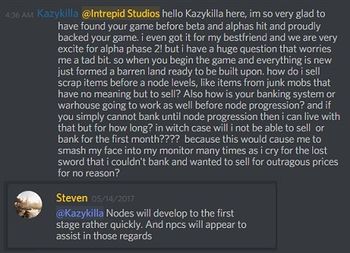
- ↑ 8.0 8.1 Liveübertragung, 2017-10-16 (50:20).
- ↑ 9.0 9.1

- ↑ 10.0 10.1 10.2

- ↑ 11.0 11.1 Interview, 2020-07-18 (10:04).
- ↑ 12.0 12.1 Interview, 2020-07-08 (1:00:15).
- ↑
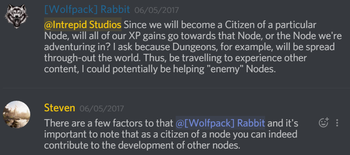
- ↑ Liveübertragung, 2021-09-24 (1:21:23).
- ↑ 15.0 15.1 Liveübertragung, 2017-05-26 (28:16).
- ↑ 16.0 16.1 16.2 16.3 16.4 Liveübertragung, 2022-10-14 (55:13).
- ↑ Liveübertragung, 2017-11-17 (55:27).
- ↑ 18.0 18.1 18.2 Liveübertragung, 2022-08-26 (1:07:34).
- ↑ 19.0 19.1 19.2 19.3 19.4 19.5 19.6 19.7 Blog - Know Your Nodes - The Basics.
- ↑

- ↑ Liveübertragung, 2023-08-31 (52:56).
- ↑ 22.0 22.1 Liveübertragung, 2022-08-26 (1:04:35).
- ↑

- ↑ 24.0 24.1 24.2 Liveübertragung, 2022-08-26 (1:10:16).
- ↑ 25.0 25.1 25.2 Liveübertragung, 2020-10-30 (39:17).
- ↑ 26.0 26.1 26.2 26.3 26.4 26.5 Liveübertragung, 2018-09-27 (53:06).
- ↑ 27.0 27.1 Liveübertragung, 2022-02-25 (41:00).
- ↑ 28.0 28.1 Liveübertragung, 2021-02-26 (1:12:18).
- ↑ 29.0 29.1 29.2 29.3 29.4 29.5 Liveübertragung, 2022-03-31 (4:57).
- ↑ Podcast, 2021-04-11 (29:47).
- ↑ Interview, 2018-05-11 (54:34).
- ↑ Liveübertragung, 2017-05-26 (21:23).
- ↑ Podcast, 2021-04-11 (23:36).
- ↑ 34.0 34.1 Interview, 2018-05-11 (47:27).
- ↑ 35.0 35.1 Liveübertragung, 2022-07-29 (1:13:09).
- ↑ 36.0 36.1 36.2 36.3 36.4 36.5 Liveübertragung, 2020-06-26 (45:32).
- ↑ 37.0 37.1 Interview, 2021-02-07 (33:00).
- ↑ 38.0 38.1 Interview, 2018-05-11 (1:00:19).
- ↑ 39.0 39.1 Podcast, 2018-04-23 (29:56).
- ↑ Steven Sharif - Clarification points from today’s stream.
- ↑ 41.0 41.1 41.2 Interview, 2018-05-11 (50:47).
- ↑ 42.0 42.1 MMOGames interview, January 2017
- ↑ 43.0 43.1 Liveübertragung, 2020-06-26 (53:41).
- ↑ Liveübertragung, 2017-05-12 (52:01).
- ↑ 45.0 45.1 45.2 45.3 Liveübertragung, 2017-05-12 (55:01).
- ↑ 46.0 46.1 46.2 46.3 Liveübertragung, 2020-06-26 (47:32).
- ↑ Liveübertragung, 2020-06-26 (54:03).
- ↑ 48.0 48.1 48.2 48.3 Interview, 2020-07-08 (33:34).
- ↑ Liveübertragung, 2020-06-26 (1:02:12).
- ↑ Liveübertragung, 2020-06-26 (56:08).
- ↑ 51.0 51.1 51.2 51.3 Liveübertragung, 2019-05-30 (1:23:41).
- ↑ 52.0 52.1 52.2 52.3 52.4 52.5 52.6 52.7 Liveübertragung, 2017-05-10 (30:53).
- ↑ Interview, 2023-07-09 (38:14).
- ↑

- ↑ Interview, 2020-07-08 (40:20).
- ↑ 56.0 56.1 56.2 56.3 Video, 2020-05-31 (47:32).
- ↑ Liveübertragung, 2020-06-26 (53:20).
- ↑ 58.0 58.1 58.2 Interview, 2023-07-09 (41:22).
- ↑ Development Update with Freehold Preview.
- ↑ Interview, 2021-02-07 (42:41).
- ↑ 61.0 61.1 Liveübertragung, 2020-10-30 (44:22).
- ↑ Liveübertragung, 2017-05-05 (32:11).
- ↑ Liveübertragung, 2020-05-29 (1:03:35).
- ↑ 64.0 64.1 About Ashes of Creation.
- ↑ Video, 2019-07-16 (0:00).
- ↑ Liveübertragung, 2017-05-15 (45:20).
- ↑ Interview, 2017-01-20 (4:19).
- ↑ Interview, 2018-05-11 (28:21).
- ↑

- ↑ Video, 2016-12-04 (0:02).
- ↑ Video, 2017-04-30 (5:31).
- ↑ Liveübertragung, 2022-01-28 (17:50).
- ↑ Liveübertragung, 2020-12-22 (1:13:51).
- ↑ 74.0 74.1 Podcast, 2018-08-04 (1:35:58).
- ↑ Liveübertragung, 2017-05-03 (36:25).
